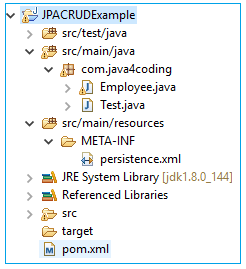| ☰ See All Chapters |
JPA CRUD (Create, Read, Update, Delete) Methods and Example
In this tutorial we will learn how to perform CRUD (Create, Read, Update, and Delete) operation in JPA and the methods used for CRUD operation. First will learn the methods used in CRUD operation. Below table explains the methods used for CRUD operation.
Result | Method | Description |
Insert | ||
void | persist(Object entity) | First entity class object is assigned with an identifier (internally assigned by JPA or programmer given value). This entity class object is then persisted. Returns void. |
Update | ||
Object ref =
| merge(Object entity)
| Merge the state of the given entity into the current persistence context. Returns an updated persistent instance. When we try to update an object which is not yet been assigned identity earlier, which means trying to merge fresh new entity object will persist a new record to database. |
Reading single row | ||
Object ref =
| find(Class clazz, Object id) | Return the persistent instance of the given entity class with the given identifier, or null if there is no such persistent instance. Parameters: Class clazz – Argument should be Class object of the class (persistent class) which represents required Table in DB. Class object represents the runtime class of the object. Example: Class.forName("com.java4coding.Employee") Or Employee.class Object id – identity value of the record which we want. This can be primitive value also, in such cases Autoboxing happens. There other overloaded find() methods present in the API to read the single record from database. Refer the JPA javadocs for the details. |
Delete | ||
void | remove(Object entity) | Remove the entity instance. Trying to remove an instance which is not there in database will be considered as transient object and JPA will remove this transient object. |
JPA CRUD example
Database script
CREATE TABLE `EMPLOYEE` ( `empid` INT NOT NULL , `firstname` VARCHAR(45) NULL , `lastname` VARCHAR(45) NULL , `email` VARCHAR(45) NULL , PRIMARY KEY (`empid`) ); |
pom.xml
<project xmlns="https://maven.apache.org/POM/4.0.0" xmlns:xsi="https://www.w3.org/2001/XMLSchema-instance" xsi:schemaLocation="https://maven.apache.org/POM/4.0.0 https://maven.apache.org/maven-v4_0_0.xsd"> <modelVersion>4.0.0</modelVersion> <groupId>com.manum.hassan</groupId> <artifactId>JPACRUDExample</artifactId> <packaging>jar</packaging> <version>1.0-SNAPSHOT</version> <name>JPACRUDExample</name> <url>https://maven.apache.org</url> <dependencies> <dependency> <groupId>junit</groupId> <artifactId>junit</artifactId> <version>3.8.1</version> <scope>test</scope> </dependency> <dependency> <groupId>org.eclipse.persistence</groupId> <artifactId>javax.persistence</artifactId> <version>2.0.0</version> </dependency>
<dependency> <groupId>org.hibernate</groupId> <artifactId>hibernate-entitymanager</artifactId> <version>4.2.8.Final</version> </dependency>
<dependency> <groupId>mysql</groupId> <artifactId>mysql-connector-java</artifactId> <version>8.0.11</version> </dependency> </dependencies> </project> |
persistence.xml
<?xml version="1.0" encoding="UTF-8"?> <persistence xmlns="https://java.sun.com/xml/ns/persistence" xmlns:xsi="https://www.w3.org/2001/XMLSchema-instance" xsi:schemaLocation="https://java.sun.com/xml/ns/persistence https://java.sun.com/xml/ns/persistence/persistence_2_0.xsd" version="2.0">
<persistence-unit name="JPACRUD"> <provider>org.hibernate.ejb.HibernatePersistence</provider> <properties> <property name="hibernate.connection.url" value="jdbc:mysql://localhost:3306/study" /> <property name="hibernate.connection.driver_class" value="com.mysql.cj.jdbc.Driver" /> <property name="hibernate.connection.username" value="root" /> <property name="hibernate.connection.password" value="root" /> <property name="hibernate.archive.autodetection" value="class" /> <property name="hibernate.show_sql" value="true" /> <property name="hibernate.format_sql" value="true" /> <property name="hbm2ddl.auto" value="update" /> </properties> </persistence-unit> </persistence> |
Employee.java
package com.java4coding;
import java.io.Serializable;
import javax.persistence.Entity; import javax.persistence.Id; import javax.persistence.Table;
@Entity @Table(name = "EMPLOYEE") public class Employee implements Serializable {
@Id private int empId;
private String email;
private String firstname;
private String lastname;
public Employee() { }
public int getEmpId() { return empId; }
public void setEmpId(int empId) { this.empId = empId; }
public String getEmail() { return email; }
public void setEmail(String email) { this.email = email; }
public String getFirstname() { return firstname; }
public void setFirstname(String firstname) { this.firstname = firstname; }
public String getLastname() { return lastname; }
public void setLastname(String lastname) { this.lastname = lastname; }
@Override public String toString() { return "Employee [empId=" + empId + ", email=" + email + ", firstname=" + firstname + ", lastname=" + lastname + "]"; } }
|
Test.java
package com.java4coding;
import javax.persistence.EntityManager; import javax.persistence.EntityManagerFactory; import javax.persistence.Persistence;
import com.java4coding.Employee;
public class Test { public static void main(String[] args) {
// Create EntityManagerFactory EntityManagerFactory emf = Persistence.createEntityManagerFactory("JPACRUD");
// Create Entity Employee employee1 = new Employee(); employee1.setFirstname("Manu"); employee1.setLastname("Manjunatha"); employee1.setEmail("manu.m@java4coding.com"); employee1.setEmpId(1); // Create EntityManager EntityManager em = emf.createEntityManager();
// Persist entity em.getTransaction().begin(); em.persist(employee1); em.getTransaction().commit();
// Retrieve entity employee1 = em.find(Employee.class, 1); System.out.println(employee1);
// Update entity em.getTransaction().begin(); employee1.setEmail("feedback@java4coding.com"); System.out.println("Updated Employee is: " + employee1); em.getTransaction().commit();
//Updating through merge method Employee employee2 = new Employee(); employee2.setEmail("manu.m@java4coding.com"); employee2.setEmpId(1);
em.getTransaction().begin(); em.merge(employee2); em.getTransaction().commit();
// Remove entity em.getTransaction().begin(); em.remove(employee1); em.getTransaction().commit();
// Check whether entity is removed or not employee1 = em.find(Employee.class, 1); System.out.println("Employee after removal: " + employee1);
} }
|
Project Directory Structure

Output
Hibernate: insert into EMPLOYEE (email, firstname, lastname, empId) values (?, ?, ?, ?) Employee [empId=1, email=manu.m@java4coding.com, firstname=Manu, lastname=Manjunatha] Updated Employee is: Employee [empId=1, email=feedback@java4coding.com, firstname=Manu, lastname=Manjunatha] Hibernate: update EMPLOYEE set email=?, firstname=?, lastname=? where empId=? Hibernate: update EMPLOYEE set email=?, firstname=?, lastname=? where empId=? Hibernate: delete from EMPLOYEE where empId=? Hibernate: select employee0_.empId as empId1_0_0_, employee0_.email as email2_0_0_, employee0_.firstname as firstnam3_0_0_, employee0_.lastname as lastname4_0_0_ from EMPLOYEE employee0_ where employee0_.empId=? Employee after removal: null |
All Chapters

